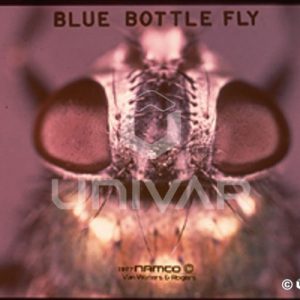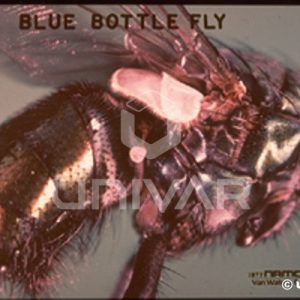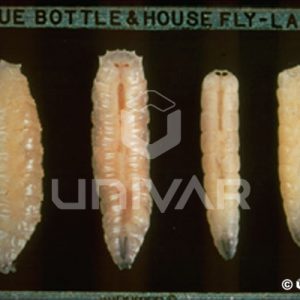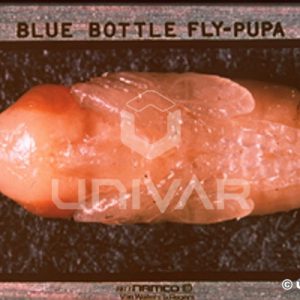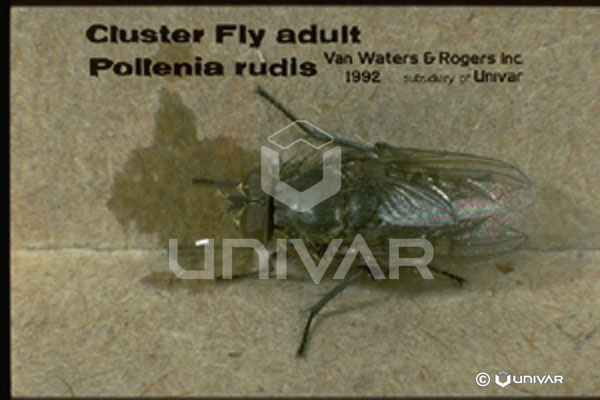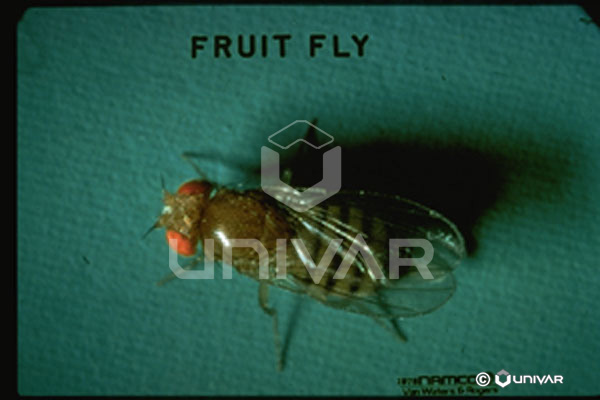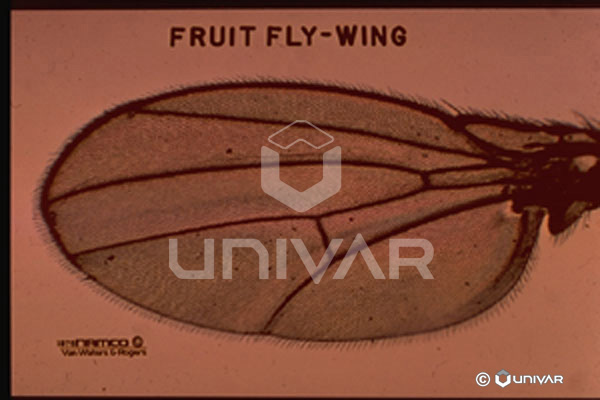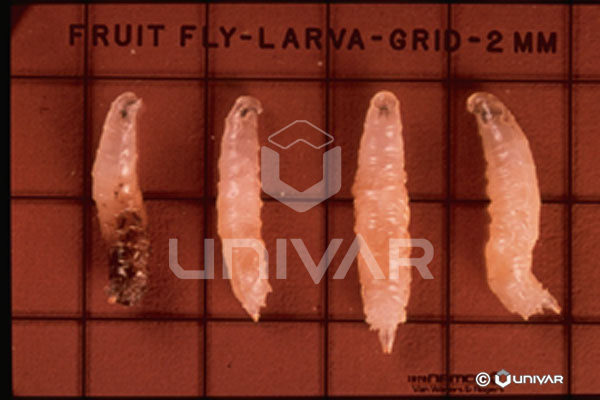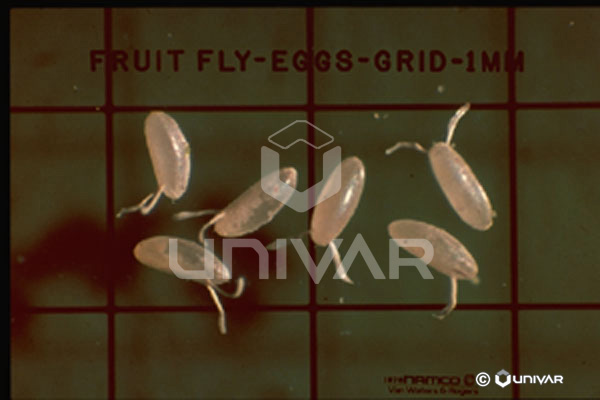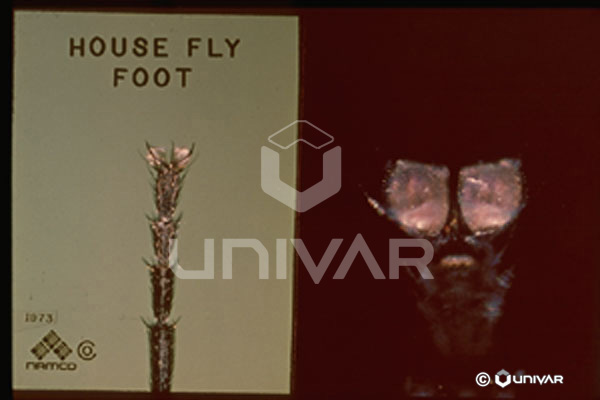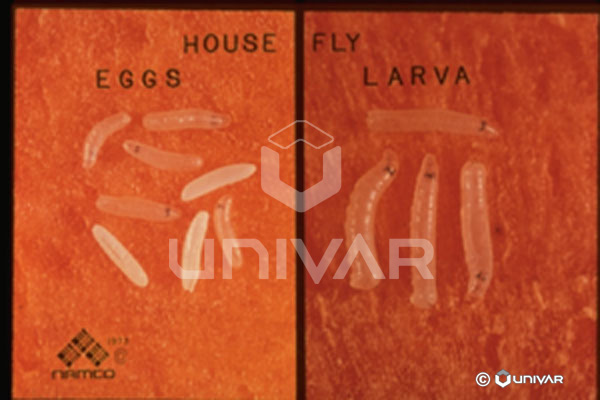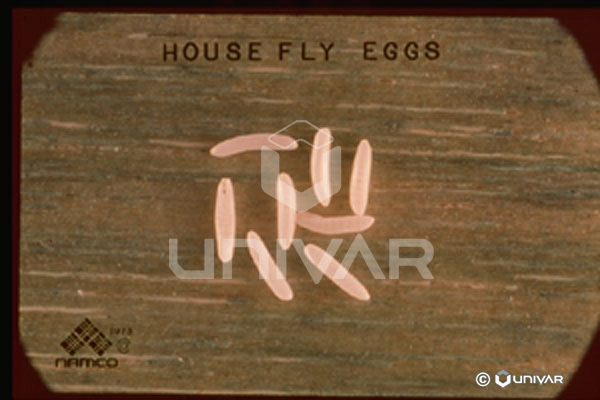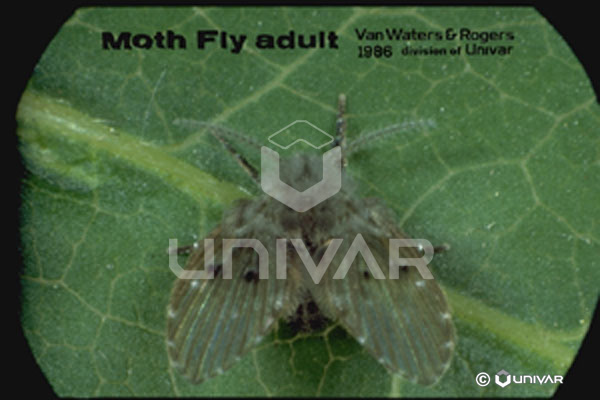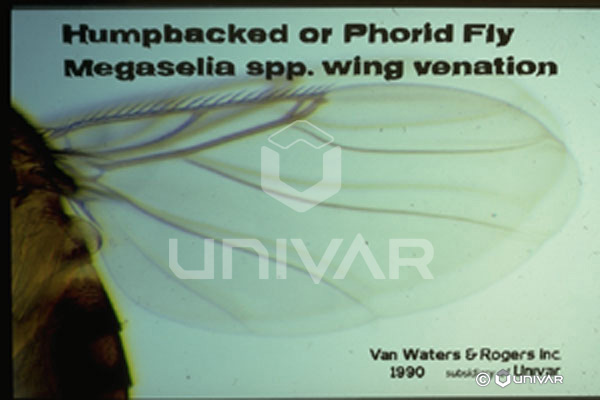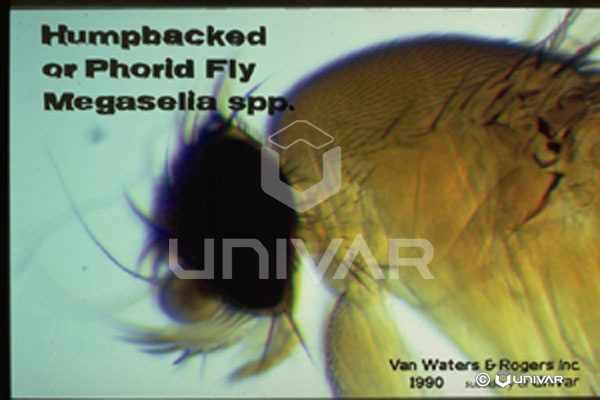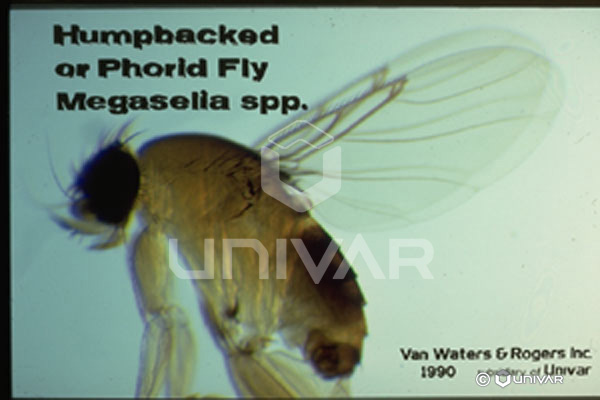
BLOW FLY
Common Name: Fly – Blow flies
Latin Name: Phaenicia sericata
Common Family Name: Blow flies
Latin Family Name: Calliphoridae
Other Names: Bottle flies
Origin: Several species that are native to North America, and widely spread throughout the continent and into Latin America.
Biology: The blow flies are important decomposers of dead animals and other rotting organic material, such as decomposing plant material. They are the first insects to arrive at a newly deceased carcass and their larvae are frequently used in forensic science to determine facts about a crime scene. The maggots also have been used in “maggot therapy”, to eat dead tissue off the skin of victims of burns or wounds. Females may lay several hundred eggs on an appropriate larval food source, with development to the adult stage being completed in about one week in hot, humid conditions. The larvae leave the food and may squirm long distances to find a protected crevice in which to pupate, often falling through ceilings or across floors because of this.
Identification: In general the blow flies are shiny and metallic, with species ranging from green to bright blue to a coppery orange to almost black, and species names are assigned accordingly. The adults are from 10 to 15 mm long and robust, with compact, wide bodies. They are loud, buzzing fliers and are strongly attracted to lights. The larvae are the typical legless, white maggots of the filth flies, with the head end noticeably tapering to a point and the posterior much wider and flattened from behind. Identification of species is done based on the specific patterns of the lines of the spiracles, found at the posterior end.
Characteristics Important in Control: Control of the source of the larvae is critical, involving cleanup and proper maintenance of garbage containers, removal of dead rodents or birds, and elimination of piles of yard debris or animal feces outdoors. Adult entry to structures is prevented by good building maintenance. The use of UV light traps is highly effective in trapping adults, along with bait granules or bait strips, and possible use of residual insecticides on surfaces the adults frequent.

CLUSTER FLY
Common Name: Fly – Cluster fly
Latin Name: Pollenia rudis
Common Family Name: Blow flies
Latin Family Name: Calliphoridae
Other Names:
Origin: Possibly native to North America, and found throughout the United States, Canada, and in Europe.
Biology: The pest significance of the Cluster fly is due to the habit of the adults gathering in large numbers within structures, where they spend the winter months. On warm winter days, they may awaken and become a nuisance within the structure. They are large flies and poor fliers and may land on arms or faces as they move about. Once spring warmth activates all the flies they emerge from the structure in great numbers to gather on walls, furnishings, or objects outdoors. When crushed they give off an unusual, sweet odor. The larvae are parasites of earthworms. The female lays eggs in the soil and the maggots seek out earthworms, which they penetrate and live within, eventually killing the worm. The life cycle from egg to adult takes about one month or a little longer.
Identification: The adult flies are unusual for their family, in that most other species of Calliphoridae are shiny and brightly colored. The Cluster fly is a dull, dark gray color, it is slightly larger than the House Fly and without the dorsal stripes on the thorax, and the thorax of the Cluster fly is covered with short, curled yellow hairs. When at rest the fly holds its wings flat over the abdomen with the tips crossed.
Characteristics Important in Control: Control of the larval stage is not possible, so attention instead is given to either preventing the entry of the adults into structures or killing them once they are hidden in voids. Closing off the small openings that allow entry is good long-term prevention, and treating enclosed voids with a dust insecticide will effectively kill the adults. If the flies are resting in large accessible voids, such as an attic, they may be captured with specialized UV light traps.
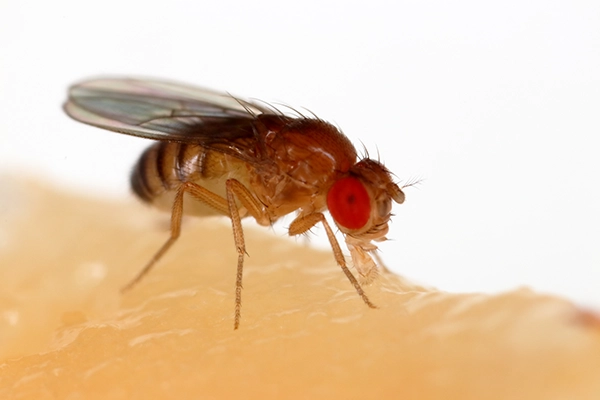
FRUIT FLY
Common Name: Fly – Vinegar fly
Latin Name: Drosophila
Common Family Name: Pomace or Fruit flies
Latin Family Name: Drosophilidae
Other Names: Pomace fly, fruit fly
Origin: Many species of these flies occur throughout the world. The species Drosophila melanogaster is one of the most common structures and is used extensively in laboratory studies of genetic characteristics.
Biology: The vinegar flies can breed in any fermenting organic material, particularly fruit and vegetable juices or damaged fruits and vegetables. They may be drawn to spills of alcohol or soda syrups, to vegetable and fruit displays in markets, and reach an abundance in the late summer and fall in gardens when fruits and vegetables tend to go unharvested and lay on the ground. Eggs are laid on the food source for the larvae and hatch within about 1 day. The larval period is less than 1 week and adults emerge from the pupa in only a day or two, with total development time averaging about 8 days. Females can lay about 500 eggs. Adult flies are attracted to lights.
Identification: The common species of Drosophila is a tiny fly, usually only 3 mm long. It has bright red eyes, a tan/orange body color, and distinct rings or stripes around the segments of the abdomen. At rest, the wings are held crossed and flat over the abdomen.
Characteristics Important in Control: Elimination of the source of the larvae is critical, and the emergence of new adult flies will continue until this source is eliminated. Any buildup of organic matter in cracks or floor drains can support larvae, along with unwashed garbage containers, spilled juices, or over-ripe fruits and vegetables. Traps exist specifically for the control of vinegar flies. Applications of residual insecticides to surfaces the adults gather on will be effective in reducing their numbers.

HOUSE FLY
Common Name: Fly – House Fly
Latin Name: Musca domestica
Common Family Name: Muscid flies
Latin Family Name: Muscidae
Other Names:
Origin: This species is found abundantly throughout the world, and in many countries, where sanitation is not adequate and human wastes are commonly deposited outdoors, the House Fly is responsible for the spread of numerous serious diseases. Included in this list are dysentery, typhoid, cholera, poliomyelitis, yaws, anthrax, tularemia, intestinal parasites, and eye parasites. It is incriminated in the spread of food infections from bacteria such as Shigella and Salmonella.
Biology: The House Fly got its name from its common occurrence in homes, particularly during more rural times when horses and livestock were common around homes, and used as transportation. It breeds prolifically, with females laying from 350 to 900 eggs in their lifetime, with a record of 2,400 eggs from a single female fly. The interval from egg to adult fly can be completed in less than one week under warm, moist conditions, and there can be many generations each year. Adult flies live as long as 54 days and females mate multiple times. Breeding sites for the larvae will be any moist, decomposing organic material, such as piled lawn clippings, animal waste, filthy garbage containers, outhouse receptacles, and decomposing plant materials. The larvae commonly leave their food source to seek a drier location in which to pupate, migrating as much as 150 feet away, and thus appearing on floors or countertops they may fall or crawl onto.
Identification: The adult fly is only about 5 or 6 mm long, and is most easily distinguished by the pattern of wing veins, the 4 dark longitudinal stripes on the top of the thorax, and the yellow sides of the abdomen on the males. On the wing, there is a distinct 90-degree upward bend of the middle vein as it nears the outer end. The larvae are a typical white, legless maggot, and the pattern of the lines of their spiracles, at the anal end, will be a distinctive characteristic of the species. The pupa is brown and egg-shaped, without any seams, and the emerging fly uses a pumping device called a ptilinum to force its way out of the pupa.
Characteristics Important in Control: Sanitation and removal of any potential breeding sites are crucial. Cleaning surfaces of spills and keeping foods covered and stored properly will reduce the attraction of flies and the potential for contamination of the food. The adults are attracted to lights, and the use of UV light traps will be very effective indoors. Fly bait granules or strips can be highly effective in killing adult flies outdoors, and treating surfaces the adults land on with a residual insecticide can also reduce their numbers. Other kinds of fly traps such as sticky boards and tubes or jars and bags that are baited will be effective as well.
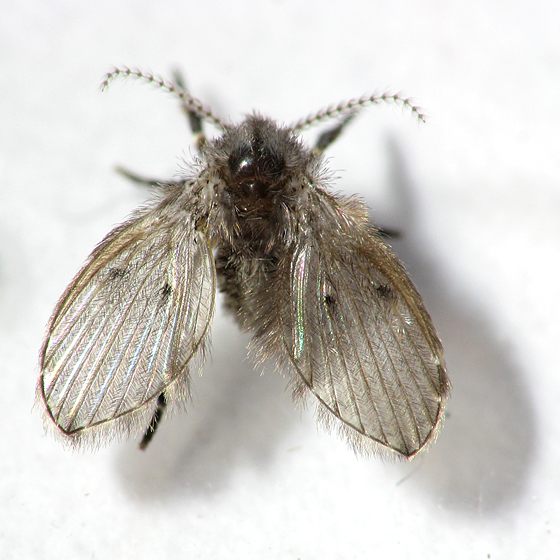
MOTH FLY
Common Name: Fly – Drain fly or Moth Fly
Latin Name: Psychoda
Common Family Name: Moth flies
Latin Family Name: Psychodidae
Other Names: Drain flies, sand flies
Origin: A number of native species of flies in this family occur throughout North America.
Biology: The genus Phlebotomus contains some species that are blood feeders, and they are vectors of several important diseases including Leishmaniasis. The larvae of this family of flies feed on organic material they find in damp situations, including on soils or leaf litter. In structures this may be a sludge buildup in floor or sink drains, giving the flies one of their common names. They may also occur in large numbers in septic systems, sewage treatment plants, or dirty garbage containers. The eggs are laid in masses of from 30 to 100 eggs, on the surface of the material in which the larvae will feed. The larvae feed within the sludge, breathing through siphon tubes on their body that project out of the material. The time from egg to adult fly may be from 8 to 24 days, depending on the temperature. Adult flies are attracted to lights.
Identification: The name “moth fly” is given due to their similarity to a small, gray moth. The adult flies are very small, and covered with short, gray hairs on their wings and entire body. The wings are oval and held flat over the abdomen, at a slight outward, or “delta”, angle.
Characteristics Important in Control: Elimination of larval breeding sources is critical, by removing sludge buildup in floor or sink drains and controlling moisture accumulation in low spots on floors or exterior areas. Regular washing of dumpsters will remove spilled materials.

PHORID FLY
Common Name: Fly – Phorid fly
Latin Name: Megaselia
Common Family Name: Hump-backed flies
Latin Family Name: Phoridae
Other Names: Hump-backed fly
Origin: These flies, including the common species found in the United States, may be found throughout the world.
Biology: Phorid flies breed in many of the same conditions that support either vinegar flies (fermenting vegetable and fruit juices and material) or drain flies (accumulations of wet organic sludge). They may also live in fungus or decaying plant tissues. Their name of “hump-backed” fly is derived from their appearance, in which their thorax is prominently arched on top. Adults are attracted to light and have the distinctive habit of running quickly across a surface when they land on it. A few species of Phoridae are parasites of ants and are being studied concerning possible bio-control efforts for Red Imported Fire Ants. Some species also have been found invading wounds in the skin of humans, and cases of myiasis (flies within human digestive tracts) are most common with these flies.
Identification: The common structural-invading phorids are very small flies, only about 3 mm long. They strongly resemble the common vinegar flies but differ by not having red eyes or banded abdomens. Their color is orange-brown, they have relatively long legs, and the profile of the thorax shows it to have a raised or “humped” appearance. Adults also have the characteristic habit of running quickly on surfaces.
Characteristics Important in Control: Elimination of the source of the larvae is critical, and the emergence of new adult flies will continue until this source is eliminated. Any buildup of organic matter in cracks or floor drains can support larvae, along with unwashed garbage containers, spilled juices, or over-ripe fruits and vegetables. Production of large numbers of these flies may be associated with broken plumbing beneath concrete slabs or within walls.

